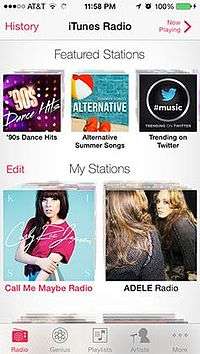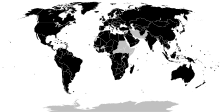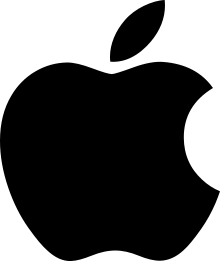iTunes Radio
iTunes Radio was an Internet radio service by Apple Inc. that let users listen to automatically generated playlists based on direct input as well as collected data on music preferences. It was launched on September 18, 2013, as part of iOS 7 and was available in the Music app on iOS devices and Apple TV (2nd generation and newer) as well as in iTunes 11.1 on OS X (10.7 Lion; it requires Mac OS 10.7.5 or newer to run) and Windows.[1][2] It was only available in the United States and Australia.[3]
 | |
 iTunes Radio running on iOS 7 an iPhone. | |
| Developer | Apple Inc. |
|---|---|
| Launch date | September 18, 2013[1] |
| Discontinued | January 28, 2016 |
| Platform(s) | iOS 7—iOS 9, OS X 10.7—10.11, Windows, Apple TV Radio |
| Pricing model | Free (ad-supported) iTunes Match (ad-free) |
| Availability | United States, Australia (Discontinued, all functions of iTunes Radio is now integrated and is part of the Apple Music subscription service.) |
| Website | www.apple.com/itunes/itunes-radio at the Wayback Machine (archived June 8, 2015) |
With the release of iOS 8.4 and iTunes 12.2, nearly all functions of iTunes Radio have become part of Apple's music streaming service Apple Music and was henceforth called just Radio or Apple Music Radio.[4] On January 15, 2016, Apple announced that effective January 28, 2016, iTunes Radio stations, barring Beats 1, will only be accessible by Apple Music subscribers.[5] On January 29, 2016, the iTunes Radio channel was automatically removed from all Apple TV devices (3rd Generation and earlier).[6]
History
Apple announced the Internet radio service at its June 10, 2013 Apple Worldwide Developers Conference (WWDC) keynote speech.[7] The service launched in the United States on September 18, 2013,[1] the same day as the release of iOS 7,[7] and in Australia on February 11, 2014.[3] Reports of a streaming music service from Apple circulated for weeks before the announcement.[8]
As of January 2015, iTunes Radio was only available in the United States and Australia. Apple had announced plans to offer the service in other countries.[9][10] In October 2013, Bloomberg reported that Apple had plans to expand the service to the UK, Canada, and New Zealand by early 2014.[11] With the release of Apple Music, most functions of iTunes Radio had become available in 100 countries, although iTunes Radio itself remained limited to the United States and Australia as a free service.[12]
On January 15, 2016, Apple announced that effective January 28, 2016, iTunes Radio stations, barring Beats 1, will only be accessible by Apple Music subscribers.[5] On January 29, 2016, the iTunes Radio channel was automatically removed from Apple TV devices (3rd Generation and earlier).
Service
iTunes Radio was a free, ad-supported service available to all iTunes users, featuring Siri integration on iOS. Users were able to skip tracks, customize stations, and purchase the station's songs from the iTunes Store.[2] Users could also search through their history of previous songs. The number of track skips was limited like Pandora Radio's service.[8] iTunes Match subscribers could be able to use an ad-free version of the service.[13] The service has pre-loaded stations, including a playlist of trending songs on Twitter. The service also generated a radio station based on input like a single artist with songs by them and others similar. The service's selection was expected to learn the user's preferences from input whether the user likes or dislikes the track.[8]
Apple Music integration
Former Apple CEO Steve Jobs was previously opposed to the idea of music subscription services.[14] Through its purchase of audio equipment maker Beats Electronics in 2014, Apple gained ownership of its own service Beats Music.[15][16] With Beats Music CEO Ian Rogers also becoming responsible for the ad-supported iTunes Radio service,[16] Business Insider later reported that Apple was planning to merge the two services. Apple also hired noted British radio DJ Zane Lowe to serve as a music curator.[17]
After a period of rumors and anticipation, Apple Music was announced at Apple's June 2015 Worldwide Developers Conference[18] with plans for launch later that month.[14] The "one more thing" reveal[19] had been confirmed by Sony Music CEO Doug Morris and The Wall Street Journal reports prior to the announcement. Morris added that he expected the service to restore the music industry's prior state of financial prosperity. He said that Apple Music's ad-supported streams would have a halo effect on the market where Spotify was unable to profit.[18] Hip hop artist Drake appeared onstage at the announcement event to elaborate on how he used the Connect platform. Apple also emphasized how unsigned artists could participate in Connect.[19]

Apple Music launched on June 30, 2015, in 100 countries. New users received a three-month trial subscription, which reverts to a monthly fee. A family plan allows six users to share a subscription at a reduced rate.[19] Apple originally sought to enter the market at a lower price point for the service, but the music industry rejected the plan.[14] The service debuts as an iOS device exclusive alongside the same-day iOS 8.4 update. Apple TV and Android device support is planned for a Q3 2015 launch.[19] A previously unreleased song by Pharrell Williams entitled "Freedom" was used in promotional material and has been announced as an exclusive release on the launch of the service.[20] The "History of Sound" advert for the launch of the Apple Music service was soundtracked by the tune "There Is No Light" by Wildbirds & Peacedrums, from their 2009 album The Snake.[21] Upon its launch, Beats Music subscriptions and playlists were migrated to Apple Music, and the service was discontinued.[22]
Apple Music had 10 million paying subscribers just six months after launching,[23] and as of April 2018 has over 40 million subscribers.[24]
See also
- Apple Music Radio - successor to iTunes Radio, adds support for live streaming stations and increases country availability
- Pandora Radio
References
- Steele, Billy (September 10, 2013). "iTunes Radio launches September 18th alongside the release of iOS 7". Engadget. Retrieved September 10, 2013.
- "Apple WWDC 2013: everything you need to know". The Verge. Vox Media. June 10, 2013. Archived from the original on June 10, 2013. Retrieved June 10, 2013.
- "Apple makes Australia the second country to get iTunes Radio". The Australian. February 11, 2014. Retrieved February 11, 2014.
- "Apple - Music - Radio". Apple Inc. Retrieved July 2, 2015.
- "Apple will start charging for iTunes Radio on January 28th". The Verge. Retrieved January 16, 2016.
- "As expected, iTunes Radio stations no longer available without an Apple Music subscription". 9to5Mac. January 29, 2016. Retrieved May 9, 2018.
- Hamburger, Ellis (June 10, 2013). "Apple announces iTunes Radio, a streaming music service to compete with Pandora". The Verge. Vox Media. Archived from the original on June 10, 2013. Retrieved June 10, 2013.
- Baldwin, Roberto (June 10, 2013). "Apple Dials in iTunes Radio, a New Streaming Music Service". Wired. Condé Nast. Retrieved June 15, 2013.
- "Apple - iTunes Radio - Hear where your music takes you". Apple Inc. Retrieved June 15, 2013.
- Etherington, Darrell; Dillet, Romain (June 10, 2013). "Apple Unveils iTunes Radio, A Streaming Music Service With The Full Power Of The iTunes Library". TechCrunch. Retrieved June 11, 2013.
- Andy Fixmer, “Apple Said to Expand ITunes Radio to U.K. Before Pandora", ‘’Bloomberg Technology ‘’, October 8, 2013
- Raymundo, Oscar (July 1, 2015). "Beats 1 vs. iTunes Radio: The good, the bad, and the noisy". Macworld. Retrieved July 2, 2015.
- Pepitone, Julianne (June 10, 2013). "Apple unveils iOS 7 in biggest update ever". CNNMoney.com. Retrieved June 11, 2013.
- Popper, Ben; Singleton, Micah (June 8, 2015). "Apple announces its streaming music service, Apple Music". The Verge. Archived from the original on June 8, 2015. Retrieved June 8, 2015.
- "Apple Paying Less Than $500 Million for Beats Music Streaming Service". Wall Street Journal. Retrieved June 3, 2014.
- "With Apple-Beats Deal Complete, Ian Rogers To Run iTunes Radio". Wall Street Journal. Retrieved March 16, 2015.
- "What we're hearing about the new music-streaming service Apple is developing in secret". Business Insider. Retrieved March 16, 2015.
- Plaugic, Lizzie (June 7, 2015). "Sony Music boss confirms Apple will reveal its music streaming service tomorrow". The Verge. Archived from the original on June 8, 2015. Retrieved June 8, 2015.
- Machkovech, Sam (June 8, 2015). "Apple Music is "the next chapter in music," debuts June 30". Ars Technica. Retrieved May 4, 2016.
- McIntyre, Hugh (June 25, 2015). "Pharrell's New Single 'Freedom' Will Serve As Apple Music's First Exclusive". Forbes.
- "Wildbirds & Peacedrums soundtrack Apple Music launch". The Leaf Label. June 8, 2015. Retrieved June 25, 2015.
- "Beats Music Tells Users To Switch To Apple Music". TechCrunch. AOL Inc. (Verizon Communications). Retrieved July 3, 2015.
- "Apple Music Just Did in Six Months What Took Spotify Six Years". Fortune. January 11, 2016. Retrieved January 11, 2016.
- Halperin, Shirley (April 11, 2018). "New Apple Music Head Named as Service Surpasses 40 Million Subscribers (EXCLUSIVE)". Variety. Retrieved May 9, 2018.
External links
- iTunes Radio at the Wayback Machine (archived June 8, 2015)
